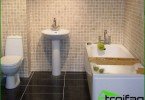How to calculate how much bathroom tiles you need
When buying bathroom tiles, it is important not only to choose the size and color that you like, but also to correctly calculate the required amount. An error in the calculations can lead to the purchase of insufficient material, the loss of nerves and time for additional searches, and sometimes, on the contrary, overpayments for surpluses. An unpleasant situation can happen if there isn’t exactly such a tile on sale, and then you have to come up with something, fill in the empty spaces with scraps or material of a different shade, and this – you must admit, will ruin the whole result of the work. It is especially important to eliminate errors in the case of lining the bathroom with expensive imported tiles, as well as additional elements and accessories – cornices, decorative borders, inserts. In this article, we will explain how to calculate how much bathroom tiles are needed..
Content
- Tile calculation landmarks
- List of accessories for the collection of tiles
- Calculation of floor tiles
- Wall tile calculation
Tile calculation landmarks
First, imagine what collection of tiles we will have in our room: on the floor there is a single-color ceramic tile, on the bottom side of the wall there will be several rows of dark tiles, then one row of a border trimmed with a decorative pencil from above and below. Above is a light tile to the ceiling with built-in decor elements. How to calculate the number of tiles? In fact, it is not difficult, you just need to correctly measure the room and apply some mathematical calculations. There are various calculation options, but here we will consider the simplest method using the given specific parameters as an example..
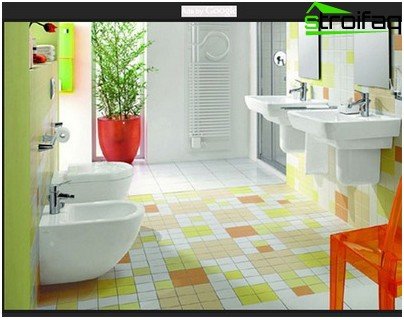
Only a whole, uncut tile is laid in a conspicuous place
List of accessories for the collection of tiles
To calculate the tiles for the bathroom, you need to make a list of components of the collection:
- floor tiles (31x31cm);
- dark wall tiles (25x30cm);
- light wall tiles (25x30cm);
- horizontal border (6x25cm);
- decor (25x30cm);
- pencil (2x25cm).
For take a bathroom as an example dimensions 1.8m x 1.9m and a height of 2.7 meters.
The doorway is 0.7m x 1.95m. We carry out the calculation for smooth walls, without taking into account possible niches and ledges. For clarity and for the convenience of calculation, it is useful to draw a plan of the room, marking the dimensions of the walls, the doorway, as well as other planes of interest that need to be calculated.
Calculation of floor tiles
The easiest way is to calculate the total floor area of 1.8m x1.9m = 3.42 m2 and divide by the area of one tile (0.31m x0.31m = 0.0961m2). We get 36 pieces.
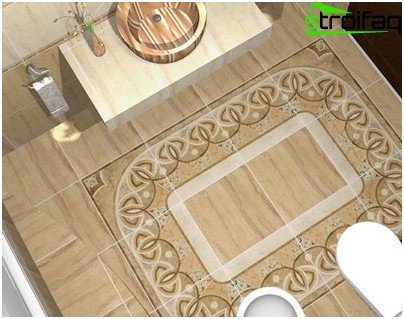
The original version of the floor tiles in the bathroom
But the calculation on tiles is considered more accurate. Divide the width of the bathroom floor by the size of the floor tiles:
1.8m: 0.31m = 5.8, do rounding up, to the whole or to half. Get 6 tiles horizontally.
Divide the length of the bathroom floor by the size of the floor tiles:
1.9m: 0.31m = 6.12. We have 6.5 tiles vertically.
The total number of tiles for the floor is: 6 x 6.5pcs = 39 pieces.
As a result, we see that the calculation for tiles is different from the calculation for area. The difference in three tiles in comparison with the first calculation is obtained because, as a rule, the dimensions of the surface of the floor or walls are not multiple of the dimensions of the tile, so it has to be cut. In addition, it is necessary to cut it in places of protrusions, niches, pipes, etc. We record the first result – 39 floor tiles.
Wall tile calculation
So, we have already gained experience in correctly calculating on floor tiles, so we know how to calculate how much tiles are needed for walls. All components (tile, decor, border, pencil) have the same width – 25 cm. Divide the width of the wall by the width of the tile:
1.8m: 0.25m = 7.2pcs? 7.5 pieces,
and wall length to tile width:
1.9m: 0.25m = 7.6? 8 pieces.
In total, we get around the perimeter: 7.5pcs x 2 + 8pcs x 2 = 31 pieces.
Now you need to subtract the tile on the doorway from the total:
0.7m: 0.25m = 2.8 pcs? 2.5 pieces (do rounding down to have a better margin than a disadvantage.
Subtract from the total: 31pcs – 2.5pcs = 28.5 pieces.
The rest is simple. A number of borders around the perimeter is 29 pieces. Since the pencil is placed on both sides of the curb (top and bottom), the required amount of this element is 58 pieces.
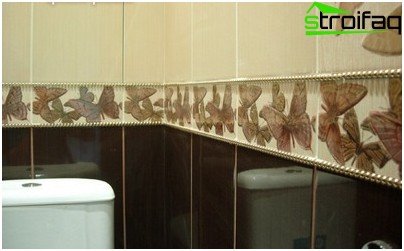
Laying tiles with decorative borders and pencils
We lay the dark tile in three rows – we get a height of 90 cm. The height of the bathroom is 60 centimeters, so 1 row of dark tiles will pass over it. Multiply 3 rows by 28.5 pieces (the number of tiles in a row around the perimeter). We get 86 pieces.
Light tiles will be glued above the border with a pencil and to the ceiling. From the total height of the room (2.7 m), subtract the height of the dark tile (90 cm) and the border with a pencil (6 cm + 2 cm + 2 cm = 10 cm):
2.7m – 0.9m -0.1m = 1.7m (the height of the lining with light tiles).
Divide 1.7m by the height of one tile:
1.7m: 0.3m = 5.67? 5.5 pcs.
In this case, we round down, since when installing a beautiful suspended ceiling, you can save some number of tiles.
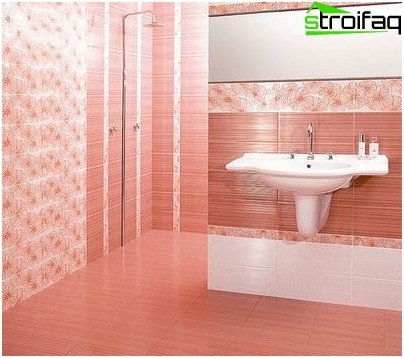
Decors in the bathroom can be glued at your discretion
Now we multiply 5.5 pieces in height by 28.5 pieces around the perimeter:
5.5pcs x 28.5pcs = 156.75? 157 pieces.
We return to the area of the wall above the door, which also needs to be faced. How to calculate the tile in this area? Here the number of tiles in width is:
0.7m: 0.25m = 2.8? 3pcs (round to a whole number).
In height we get 2.7m-1.95m = 0.75m.
0.75m: 0.3m = 2.5 pieces.
We multiply 3 pieces in width by 2.5 pieces in height, we get 7.5 (round) = 8 tiles.
The total number of light tiles is: 157pcs + 8pcs = 165 pieces.
We paste the decors at our discretion and taste: 1 or 2 on each wall, in a checkerboard pattern or another order. Tiles that will be replaced by decors (if, of course, there are not very many of them), let them be left in stock just in case (to replace tiles damaged during operation).
Now you have a general idea of how to calculate a tile for a bathroom. Accurately performed calculations will prevent situations when it may not be enough when laying tiles, and also save you from unnecessary cash costs.
So, it’s time to learn how to lay the tiles with your own hands, and start repair.


